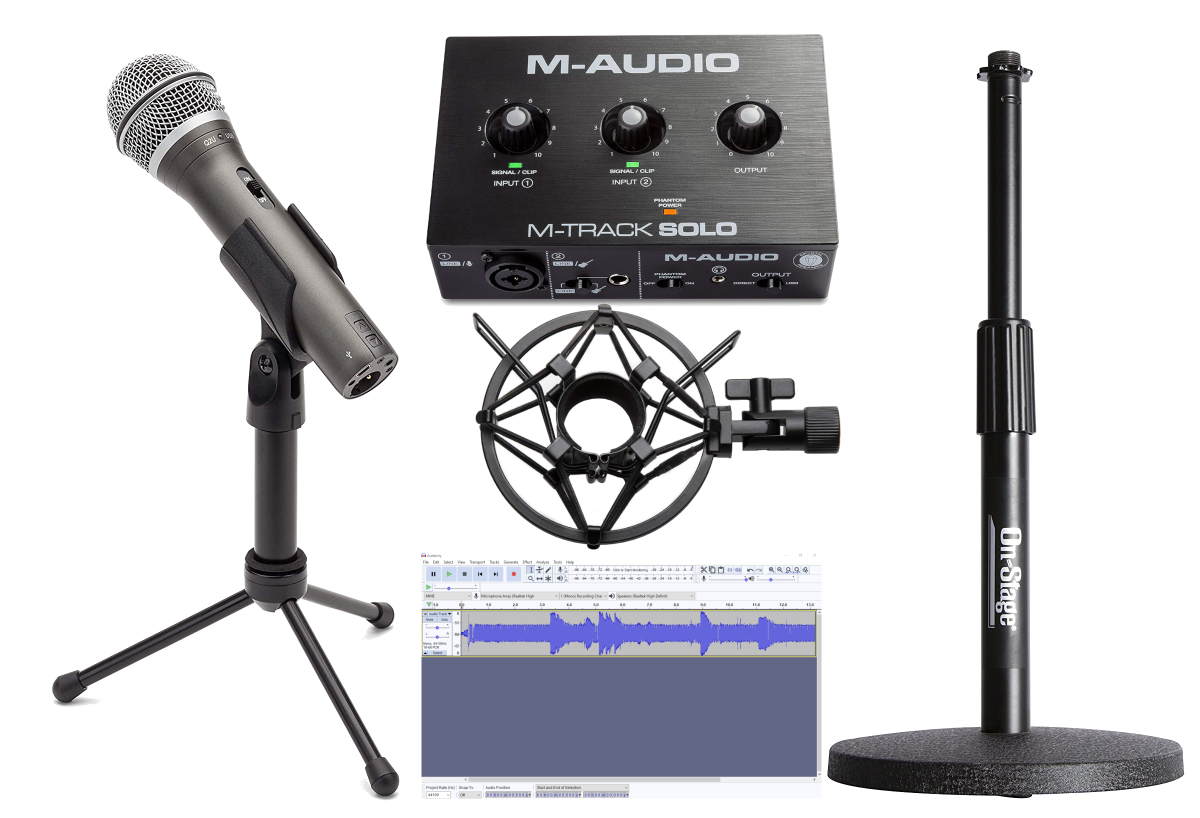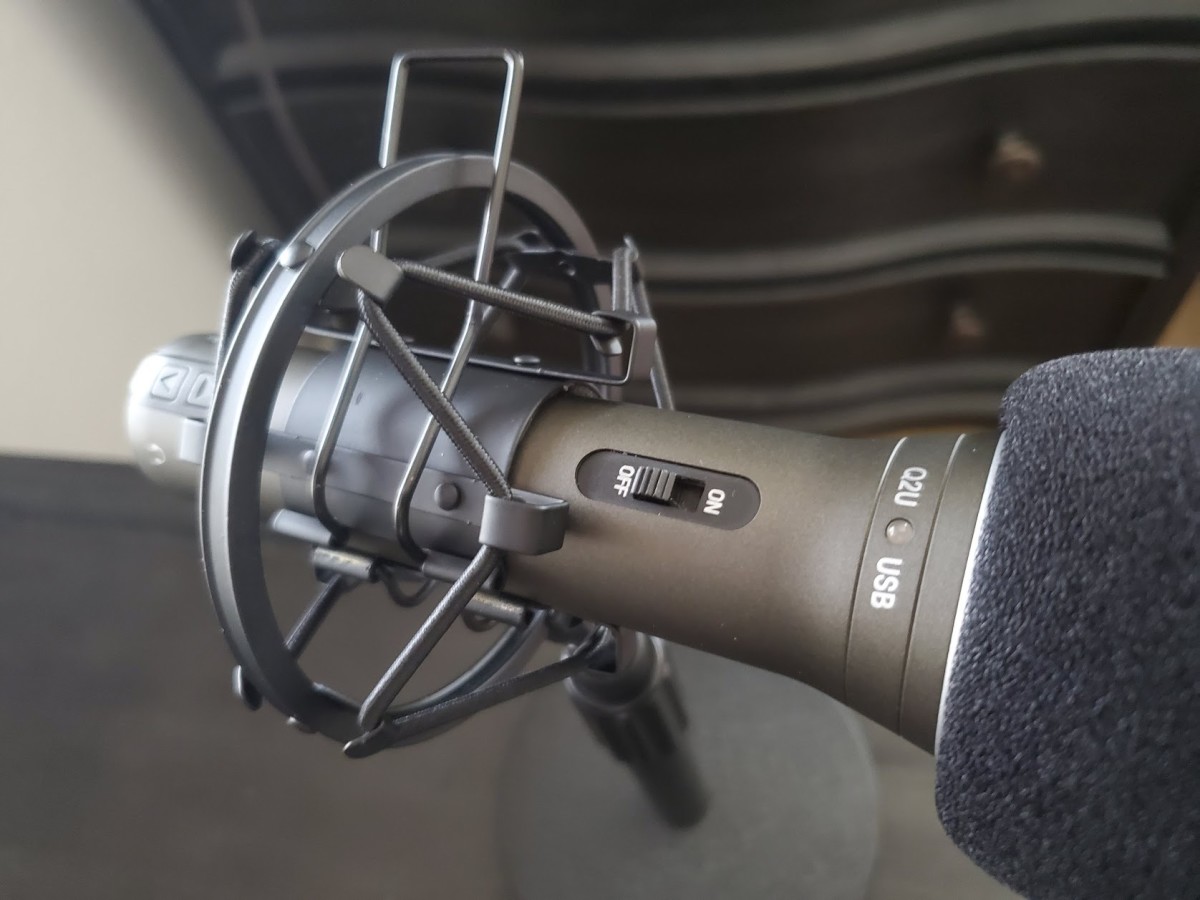AT2020USB+ Pros
Condenser microphones are often recommended for voiceovers, podcasting, and singing because they are sensitive and pick up more sounds than dynamic microphones. Another advantage of this sensitivity is you don’t have to get too close to the mic. If you plan to make YouTube videos or get into podcasting or voiceover work, a condenser mic with its clarity and range may seem like the best option.
AT2020USB+ Cons
That’s what I thought when I bought my AT2020USB+. Unfortunately, that sensitivity also picked up a lot of noise. I live in a densely populated area, and when I do recordings, I often have to stop because of the noise going on outside. To eliminate unwanted sounds, I use the ReaFIR plugin in Reaper to build a noise profile and subtract noise from the signal. But when there’s a lot of noise in a recording, the quality of the vocals can degrade as noise is removed. Some of the clarity and warmth may be removed in the process.
Different Types of Microphones
Condenser Microphones
Condenser microphones are great for people who can set up a studio or booth with plenty of sound dampening. When you’re starting out with recordings, you might want to avoid making big investments until you see how things pan out. And sound dampening options can get expensive if you live in a noisy area. Of course, this can also vary by model. Some condensers may pick up more unwanted noise than others. If you prefer to get a condenser mic, thoroughly research their levels of self-noise and how much external noise they pick up.
Dynamic Microphones
A dynamic microphone might be a better choice if you need to record in your home office, living room, or bedroom. These mics mainly pick up sound close to the mic itself, which means you have to get very close. And by close, I mean a few inches. The upside is if your neighbor’s kids are playing outside, there’s a good chance the racket they’re making won’t end up in your recording. With a dynamic microphone, you sacrifice quality for convenience. Still, you can record high-quality audio with a good dynamic microphone that works well for videos, podcasting, and basic voiceover work. Even though these microphones don’t pick up as much external noise, you still have to record in a quiet environment. Very loud noises may be picked up, such as a leaf blower running right outside your house. If possible, keep the AC and heat off, and don’t run any nearby appliances. Even though dynamic mics pick up some noise in the immediate environment, you may not be forced to end a recording session based on what’s happening outside.
Getting Started With Recording
You need a microphone, a digital audio interface, a good stand or boom arm, and a shock mount before you start recording. It’s tempting to go with a USB microphone because we’re all so used to using USB, but it’s better to choose a mic with an XLR cable. An XLR microphone requires a digital audio interface. The Samson Technologies Q2U USB/XLR Dynamic Microphone and the M-Audio M-Track Solo or Duo USB Audio Interface can get you started without breaking the bank. The Q2U costs around $70. It can be used as a USB mic, but you will get better sound quality using the XLR cable. Using XLR requires a digital audio interface. Two affordable entry-level options cost around $50. One is made by Behringer. The one I use is the M-Audio M-Track Solo. If you plan to do recordings with another person, pay a little more to get the M-Audio M-Track Duo, which has two microphone inputs.
Samson Technologies Q2U Overview
The Samson Technologies Q2U is an entry-level dynamic microphone that minimizes “ambient sounds and other room noises for podcasting, home recording or voiceover work.” It comes with both a USB and an XLR cable. It has a 3.5mm headphone jack, so you can listen to yourself while recording. However, if you use a digital audio interface, you plug your headphones into the headphone jack on the interface instead of into the mic. The Q2U also includes “a pop filter for reducing p-pops.” The stand on the Q2U is a small tripod stand that may not be sturdy enough or practical for regular users. You can get a boom arm or a sturdy stand with a 5/8" connector. I use the On-Stage DS7200B Microphone Stand. The only shock mount I’m aware of that works with the Samson Technologies Q2U, and a stand like the On-Stage is the Knox Microphone Shock Mount for Audio-Technica ATR2100-USB and Samson Q2U.
M-Audio M-Track Solo Overview
The M-Audio M-Track Solo is less than half the price of similar budget digital audio interfaces. For comparison, the Focusrite Scarlett Solo is about $120. The M-Track Solo is lighter and more delicate than its pricier entry-level counterparts. It’s made of plastic, and it does feel cheap. The gain knob makes a big jump in sound from 9 to 10, which is a strange design choice. I have to keep it at 9.5 to get loud enough audio. If I go past 9.5, the sound suddenly becomes very distorted. When I keep it at 9.5, I get clean, hiss-free recordings.
Check Your Signal/Clip Light
The signal/clip light under the gain knob turns:
green when vocals are loud enough to be picked up red when the sound is clipping
Controlling volume is much easier using the gain knob on a digital audio interface than controlling the volume for a USB mic using Windows sound controls or sliders in a DAW.
Check Your Drivers
I had no problems setting up my M-Track Solo. According to the instructions, the driver should be downloaded and installed before plugging in the device. When I installed the driver on Windows 10 and plugged in the device, it was recognized immediately. I did a test recording in Audacity with the Samson Q2U, and it worked from the get-go. I mostly use it with Reaper.
USB Cable Power
The M-track Solo gets power through the USB cable, so you don’t need an external power supply.
Everything You’ll Need to Get Started
For less than $200, you can get the Samson Q2U microphone, the M-Audio M-Track Solo, the On-Stage stand, and the Knox Microphone Shock Mount. This is all the gear you need to get started. Use blankets to reduce echo and absorb noise in your recording space. In addition to hardware, you need software. A DAW (Digital Audio Workstation) is needed for recording and editing. The M-Track Solo comes with Pro Tools First M-Audio Edition. You can also get Reaper and Audacity for free. Reaper requires a $60 license after 60 days, but if you want to continue to test it after that, it will continue to work until you’re ready to pay. Audacity is open-source, so it’s always free.
References
Condenser Vs Dynamic | A Beginner’s Guide to Microphones for VoiceThese terms refer to two different ways microphones are built, and function. Here are the potential pros and cons of both.XLR or USB Microphone for Vocals? 6 Reasons To Choose XLRWith most podcasters and musicians producing material from home, it’s important to know how to get the most out of your microphone.
This article is accurate and true to the best of the author’s knowledge. Content is for informational or entertainment purposes only and does not substitute for personal counsel or professional advice in business, financial, legal, or technical matters. © 2021 LT Wright


